I went to Saltillo, Coahuila, Mexico.
. Day .
I spent a Mardi Gras going with some Loyola classmates to Saltillo, Coahuila, Mexico to work on houses. We actually ended up building a small chapel.
We drove from New Orleans to Saltillo, Coahuila, crossing the border at Laredo. Saltillo is the "beneficiary" of Monterrey's increasing prosperity: as jobs move over the border into Monterrey, wages there rise, and companies look further south for cheap labor. (NOTE: All political stuff is either hearsay, or it's my creation, and may well be bullshit. I just know for a fact that there are poor people there.) Saltillo is really like Birmingham. It's gray and industrial, about half a million people live there, it has a lot of car plants. One difference is its elevation is over 5,700 feet, higher than Denver I think, and its slums are creeping up to the feet of the highest peaks of the rocky, uninviting Sierra Madres.
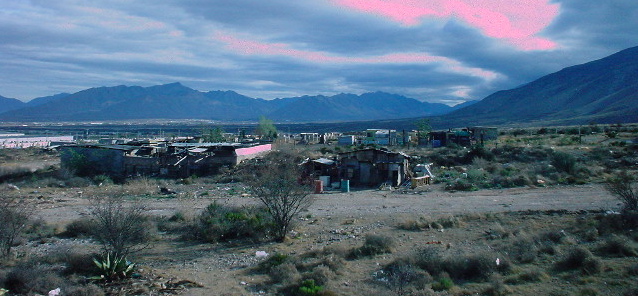
This is the view from over the wall of Mision San Miguel, where we stayed. It is located amongst houses that are often just shanties. In this picture you can see houses made of bloques (cinderblocks, a common material there), a good old trailer, and the closest one is a hodge podge of corrugated tin, cardboard, and shipping pallets. The odor of pigs is not apparent from this photograph.
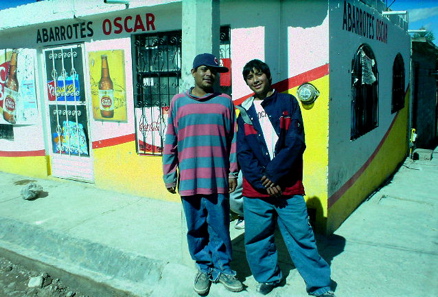
An abarrotes is like what you would call a bodega in New York City--a little shop. (A bodega in Mexico is a storehouse, or warehouse.) The exchange rate in small stores is "diez pesos para dolar" (ten pesos to the dollar, and I doubt I have the right preposition...I just faked my Spanish). It's easier that eleven, the official rate, and they make nine cents more on your dollar. I didn't need anything at all, but I bought a lot of candy (Mexican candy is frequently covered with cayenne pepper, by the way) because it's fun. they have a lot of tamarind flavored candy which is kind of more tamarindy than I personally prefer.
These guys just started talking to us. They insisted I take their picture. I showed it to a little kid, who just said "Muertes!" Dead men? I don't know...maybe that's not what he said. Anyway, the one on the left had tears tattooed on his face, and sonebody told me that means he killed somebody, but I'm very gullible.
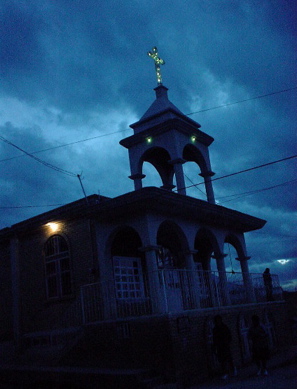
The church by the mission.
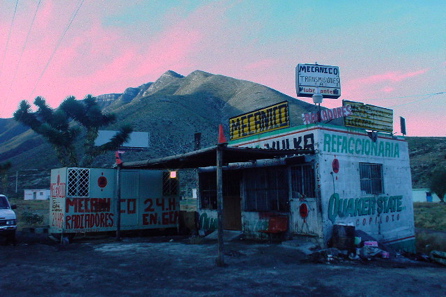
On the way to the work site. These little tallers (mechanic's shop) are a common sight. One thing I loved in Mexico, something you notice immediately upon crossing the border, is that they have a lot of hand-painted signs, most of which are very well done (this one, not so much).
Shortly after I took this picture, I had a conversation with Arlene, the chaplain of the law school, and one of the organizers of the trip. she came to me, which I thought was important, to ask me if the trip was what I expected. And I told her I was having a good time and willing to work, but I had expected to be building houses for the poor, that that was how the trip was sold to me, and what the people at home expected me to be doing. and what happened was, we wound up building a church, out in the country, miles from nowhere, when there was all this poverty and poor housing right around the mission.
At least Arlene told me the reason. The mission has to own the land to build a house on it, and at the time we got there, they didn't own any. The people of this tiny country village (really just three houses) called Las Blancas had asked for a church, so...we went to build them one. I talked with other people in my group, both Catholics (this was a Catholic mission trip, sponsored by a Catholic school, so, no surprise things got a little Catholic) and non-, and there was a sense of disappointment that we weren't directly addressing the poverty that we saw. At the same time, we were asked to do this thing, we were stuck there, so, we did it. For whatever reason people were there, we worked really hard to do what was asked of us. I was there to be away from Mardi Gras, to see a foreign country where they don't speak my language, and to help people, and I got to do all that. I was glad to do it. Would I do it again? They've asked. The answer is "yes--if we build a house in Saltillo."

This is Chucho (or Lucho.) We thought his name was Lucho. (He answered to it!) Chucho is short for Jesus. He lives in Las Blancas. All the kids bug you constantly but he was the most present. He was generally sitting in the carretilla (wheelbarrow) when you wanted to use it. The best Chucho story goes like this: we brought lots of peanut butter and jelly, which I happen to think is gross, to the site, because we are nice Americans. Somebody made this kid a sandwich. Well, this picture is Chucho reaching for my sandwich. I was eating it! I don't have a three-year old. Sorry! so he went to Victor, a fellow law student, fluent in Spanish, who does have a three year old. Victor also had a ham sandwich. "No quiero," says Chucho, holding out this dirty PB&J: I don't like it. And he reached for Victor's sandwich. And Victor gave it to him. And Victor ate Chucho's sandwich. Victor is LIVING IT.
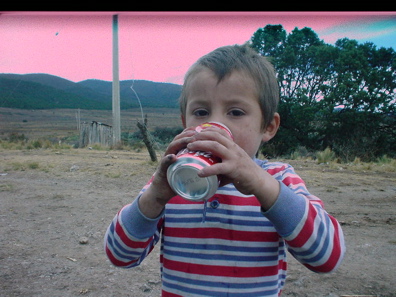

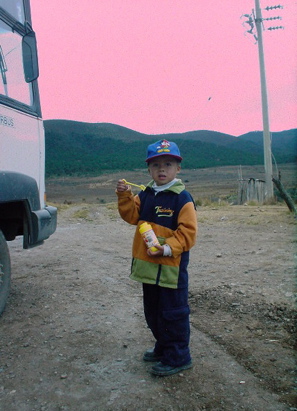
I want to say this kid's name was Leopoldito.

Jorgito? The kids go crazy over bubbles. I'm not sure they had ever seen them. One fantastic sight was watching this bunch of kids, all boys, chase a single stalwart methuselah of a bubble, cheering it along as it went over the house and down the road out of sight before popping.

Juanito.

Chucho.


This is the picture that made the kid (Juanito) say to me "You look like a burro."
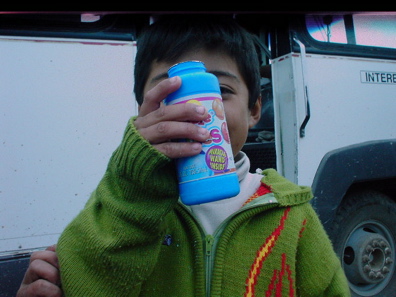
He wanted his picture like this.

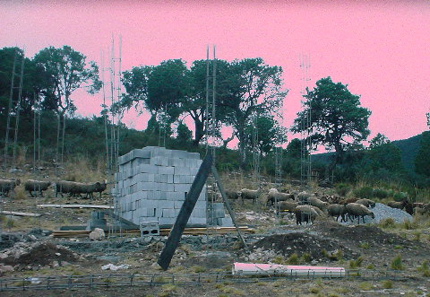
Sheep ate the gravel.
This is the worksite. you can see how small the church is. Most villages (ranchos) we went through had a church about this size, maybe 30' x 30'.
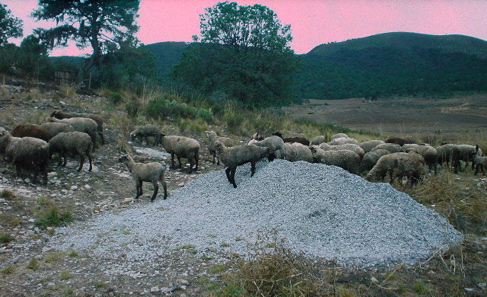

Auto parts tied to a wire fence for easy selection. I wish I had a better picture. We saw this kind of thing more than once.
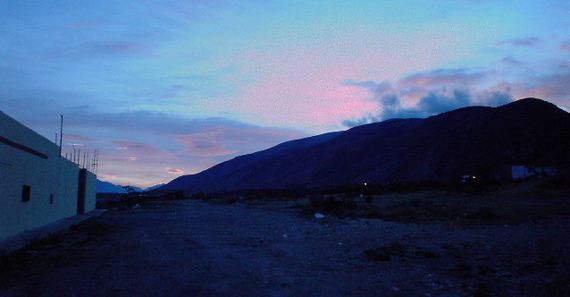
Night fall, behind the mission.

More of the poor housing around the mission. For the people in the barrio around the mission to get power, they splice orange drop cords into the wires. When it rains hard, the power drains out into the dirt, basically, and the lights go dim.
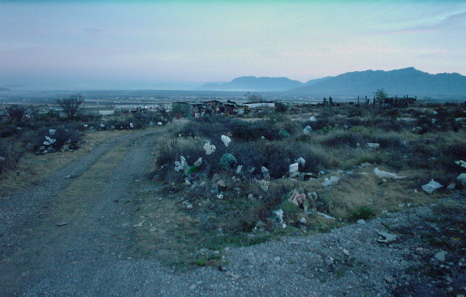
Plastic bags everywhere.
There's no garbage pickup in this part of town. Some people have a little wrought iron basket on a stilt in front of there house to leave the trash in. A man with a donkey cart might come pick it up. Out in the country they toss it off a little cliff where it's hard to see.
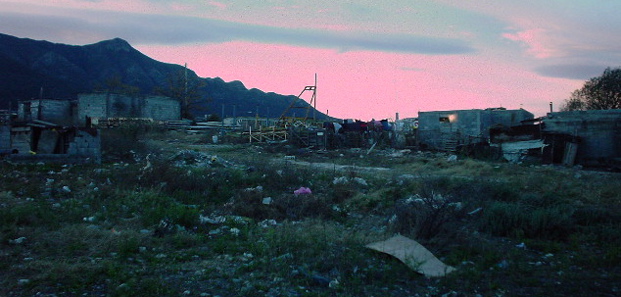
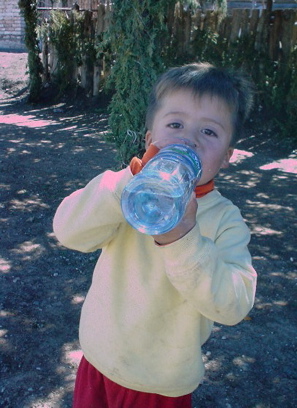


More kids, toys.
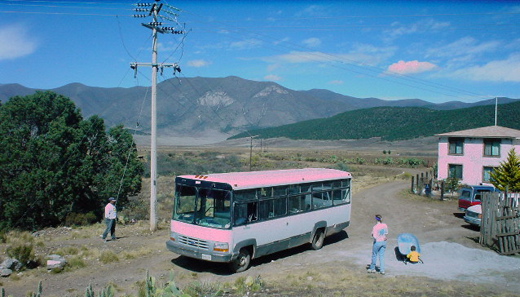
They do have electricity. That's our bus. It took three hours to get to the work site and three hours back. Thirty miles: mostly dirt. Look at those mountains. Also, notice the kid playing with the carretilla.
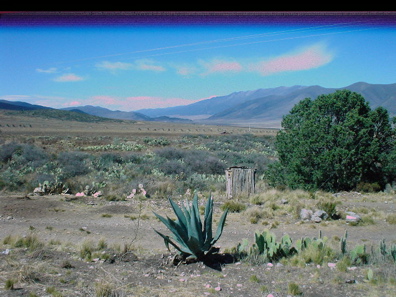
The outhouse, and the view from the outhouse.

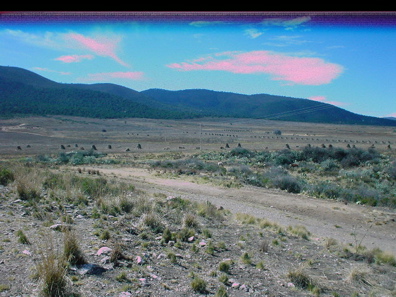
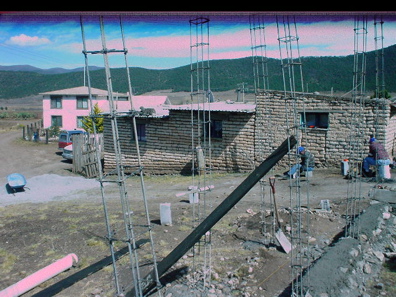
Rebar in place.
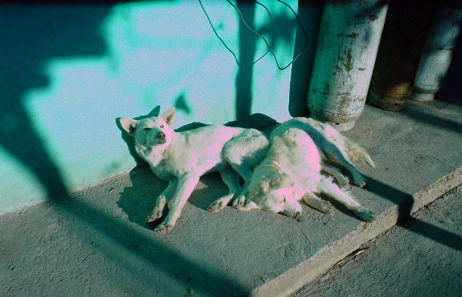
Don Matias' dogs.
One night four of us who were doing the consruction work just couldn't face the bus ride home and back, so we asked if we could just stay in the village. Don Matias, a wheat farmer from the rancho called La Cienega, offered to put us up. for out there he was a rich guy. He had running water and spare bedrooms. The only problem with staying there was his wife fed us, and we had already eaten a huge, fantastic meal at the house by the worksite. Our poor compatriot Tim, at eighteen the youngest of us, just could not force himself to eat any more of Doña Lola's cooking. She kept telling Victor, in Spanish, "I can tell he doesn't like it," and offering more food --an egg, anything. I felt terrible for him as I was dying myself. Victor explained that Tim was just a dumb kid who ate lots of junk food because he didn't know any better. Not true but funny.
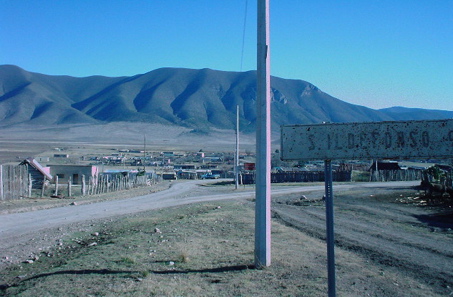
View from Don Matias' driveway.
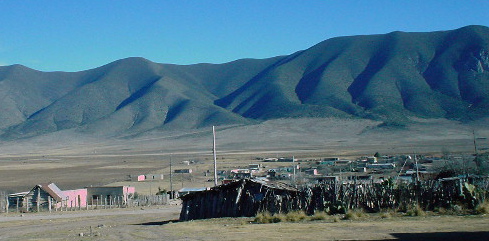
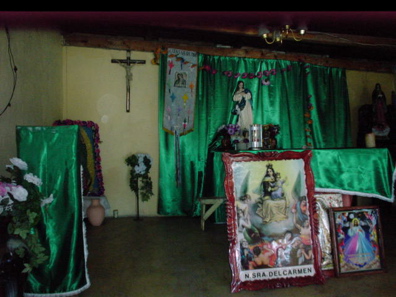
The church at Cienega.
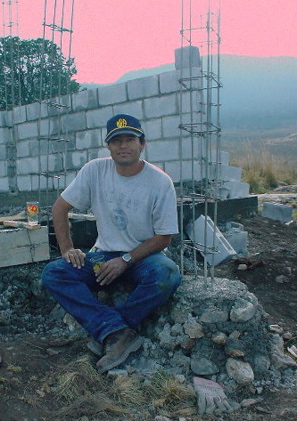
Mario was sort of the boss of the job. He worked for the mission and seemed to know everybody. Nice NRA hat, Mario. I saw a lot of Michigan and Michigan State clothing down there, so I guess that rivalry's going strong. It is kind of a fact that you see a lot of secondhand American clothes with incongruous messages. That disappointed me somehow.
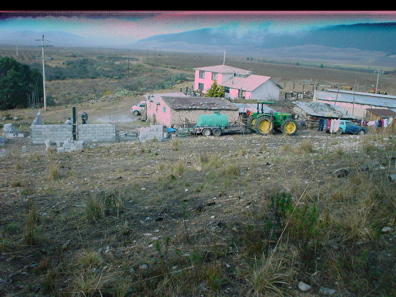
Las Blancas, as we left it.
With all the work we did this is as far as we got. I don't think all that driving helped us much. Someone would come along the next week and finish it. Really, putting in the foundation is the hard part. the bloques go up fast. I can tell you we worked hard. I wish we could have done more.
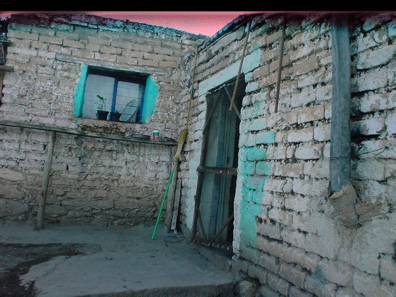
Adobe house. This is the kitchen door. Tortillas inside...
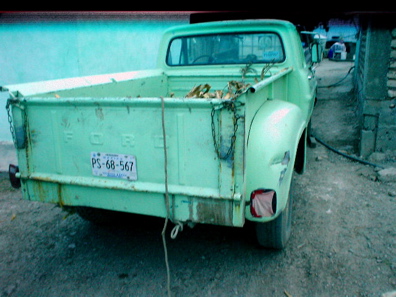
I just like the color of this truck.

Cathedral in Saltillo. I want to go back and go inside...I'm a fool. I should have seen the inside. It's astonishing on the outside, really beautiful and strange, even kind of pagan. Instead I went to check my e-mail.
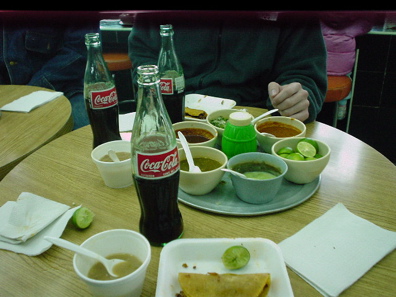
At Tacos El Pastor. This place was great.

Victor, Oscar, y Mario. Oscar was referred to as 'the talkative one' by Don Matias and his wife; he was always giving orders, which was okay by us because he's deaf and communicated by sign language and barks, kind of like we did.
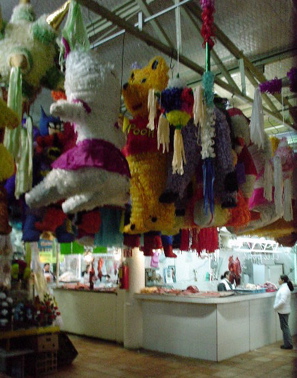
Piñatas and meat.
They display the meat in such a way as to suggest CARNAGE. Livers are hung over the shelves so you can se how...livery they are. Tripes are stretched like sails. People sit and eat menudo right by these stalls, and why not?
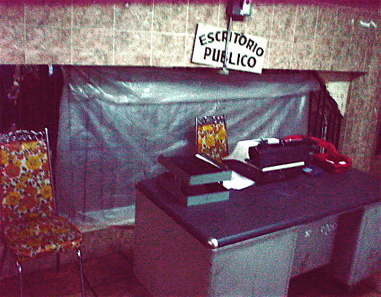
Public typewriter.
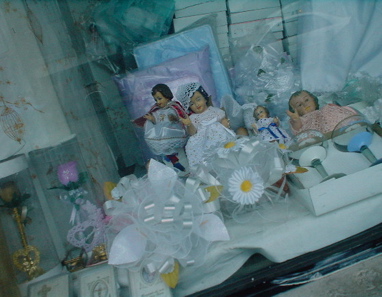
I took this for a friend I knew would appreciate it. A store display, reminds me of old southern towns, and Gay Street in Knoxville. Downtown Saltillo reminded me of Boston, but maybe because it was cold and foggy.

Tim and I went for a walk with no Spanish speakers. This was frowned on as we were in a terrible slum but we did it anyway. It was foggy and dark. A kid leaned out his door and yelled four times: "OW ARE YEW?" I asked some cute girls at a bootleg video store if they could cambiar dolares ("to change dollars", I wanted to buy a copy of Will Smith's new movie "Yo Robot"). I did this to embarrass Tim. After a while this walking in the fog seemed kind of pointless to continue. I suggested we wait for one more interesting thing to happen, then go back. Right then a guy on a bike with a loud horn rode up and sold me an elote--an ear of corn with sour cream and cayenne pepper painted on it.
We got lost going home. I asked a woman, "Senora, donde es Mision San Miguel?" she looked at me like I was crazy and pointed over my head. We were about five feet from the wall. It was foggy and I was in Mexico.
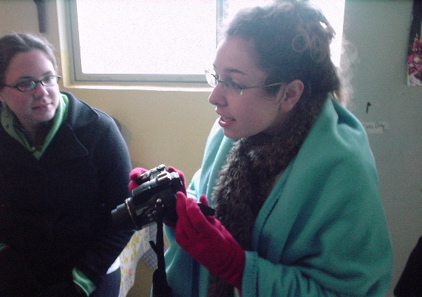
Kathleen and Lindsey.
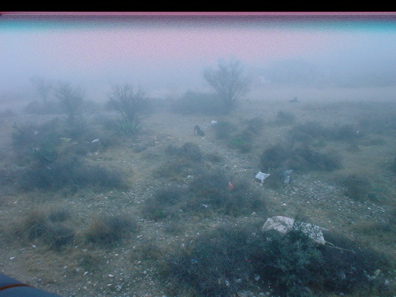
View from the mission.
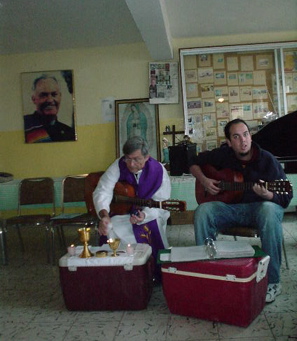
Father Eddie and Juan, with Igloo brand altars.
I did not particularly love the singing during the nightly Catholic portion of our show, but I did enjoy jamming with Father Eddie on r&b classics.
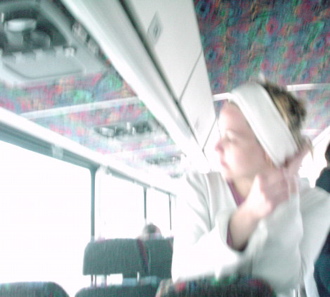
Going home.
I lied about the yellow school bus too. I mean, I didn't lie, but it was much nicer than was represented to me. Unfortunately, it had video capability and I had the displeasure of seeing not only the cloying and stupid Forrest Gump, but also the loathsome What Dreams May Come. Man, it sucked. I went to Mexico to escape from Robin Williams!
That's all for now. Thanks again for supporting me. I had an amazing experience; I hope it was helpful to somebody else. I forgot to mention, I spent part of Mardi Gras night hiking to a waterfall about 3,000 feet up in the mountains. I bought a case of Coronitas at a house in a rancho from an old man whose ancient wife was snapping feed corn off the cob and blasting Mexican gangster rap (Victor: "Oh, that's Molotov. Very popular.") I got asked, in English, why Americans want to learn French instead of Spanish (we're snobs, right?). Drank the water. Rode a horse that would not turn around and had to be rescued. Got as dirty as I have ever been in my life. Oh, ask me about looking at the sunset, if you want to hear a funny story, I'm not writing it here.
I'd like to do it again.
Previous: January 26, 2002: The Sleepyheads played another show at Circle Bar.
Next: April 23, 2002: Dirty Knives played Strathmore Ballroom.